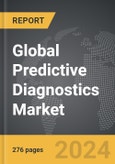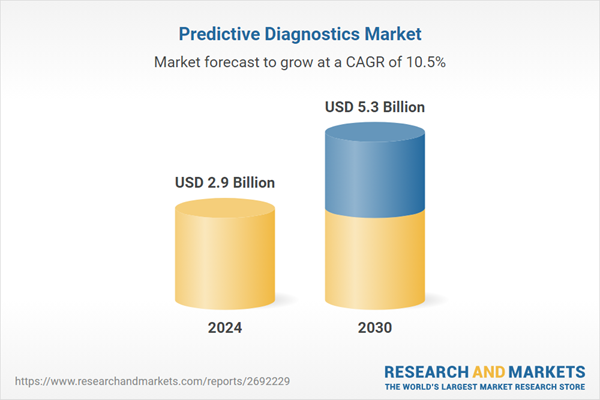Global Predictive Diagnostics Market - Key Trends and Drivers Summarized
Preventive healthcare is experiencing a transformative shift from reactive to proactive medical practices, emphasizing early detection and prevention to manage health risks before they develop into more severe conditions. This proactive approach includes regular screenings, vaccinations, and educational outreach, aimed at fostering a healthier population. Preventive screenings, in particular, have become an integral part of modern healthcare, offering early warnings and preventing serious health outcomes. For instance, in India, the popularity of home-diagnostic tests is surging, particularly for conditions like Type II diabetes where early detection can prevent complications such as heart failure. Similarly, early cancer screenings, like HPV tests for cervical cancer and routine checks for breast cancer, have significantly improved survival rates. These preventive measures not only lead to better health outcomes but also reduce the economic burden by minimizing the need for extensive treatments and hospitalizations.Technological advancements are making preventive care more efficient and widespread. Artificial intelligence (AI) and machine learning (ML) are enhancing diagnostic accuracy, enabling earlier detection of diseases such as heart conditions and Alzheimer's. The FDA has recognized AI-based diagnostic tools for their precision in identifying cancer, which highlights their potential to improve healthcare delivery, especially in resource-limited environments. Additionally, healthcare organizations are increasingly leveraging vast data pools through predictive analytics, which utilizes ML and advanced analytics to extract insights that enhance operational efficiency and patient care. This approach helps in disease prevention and management, improving patient outcomes by predicting disease progression and facilitating early intervention. The Internet of Things (IoT) technology further augments this by allowing real-time monitoring of patient health, enabling timely medical interventions that prevent conditions from worsening, thus reducing hospital visits and enhancing overall patient outcomes.
Despite the benefits, the adoption of predictive diagnostics and early detection technologies faces challenges such as establishing demand, educating patients on the benefits, and securing financial and regulatory support for these innovations. To address these obstacles, healthcare organizations need to conduct thorough market research, form strategic partnerships, and invest in research and development. Protecting intellectual property and integrating new technologies into existing healthcare systems are also vital for expanding the scope of preventive healthcare. The broader adoption of predictive diagnostics heralds a major transformation in healthcare, focusing on prevention and early intervention. This approach not only aims to reduce healthcare costs but also enhances the quality of life, setting a foundation for a resilient future in global healthcare systems.
Scope of Study:
The report analyzes the Predictive Diagnostics market in terms of units by the following Segments, and Geographic Regions/Countries:- Segments: Segment (Predictive Diagnostics)
- Geographic Regions/Countries: World; United States; Canada; Japan; China; Europe (France; Germany; Italy; United Kingdom; and Rest of Europe); Asia-Pacific; Rest of World.
- Regional Analysis: Gain insights into the U.S. market, estimated at $821.4 Million in 2024, and China, forecasted to grow at an impressive 9.9% CAGR to reach $804.8 Million by 2030. Discover growth trends in other key regions, including Japan, Canada, Germany, and the Asia-Pacific.
Why You Should Buy This Report:
- Detailed Market Analysis: Access a thorough analysis of the Global Predictive Diagnostics Market, covering all major geographic regions and market segments.
- Competitive Insights: Get an overview of the competitive landscape, including the market presence of major players across different geographies.
- Future Trends and Drivers: Understand the key trends and drivers shaping the future of the Global Predictive Diagnostics Market.
- Actionable Insights: Benefit from actionable insights that can help you identify new revenue opportunities and make strategic business decisions.
Key Questions Answered:
- How is the Global Predictive Diagnostics Market expected to evolve by 2030?
- What are the main drivers and restraints affecting the market?
- Which market segments will grow the most over the forecast period?
- How will market shares for different regions and segments change by 2030?
- Who are the leading players in the market, and what are their prospects?
Report Features:
- Comprehensive Market Data: Independent analysis of annual sales and market forecasts in US$ Million from 2024 to 2030.
- In-Depth Regional Analysis: Detailed insights into key markets, including the U.S., China, Japan, Canada, Europe, Asia-Pacific, Latin America, Middle East, and Africa.
- Company Profiles: Coverage of players such as Abbott Molecular, Almac Group Ltd., Ambry Genetics Corp., BioGenex, Epistem Ltd. and more.
- Complimentary Updates: Receive free report updates for one year to keep you informed of the latest market developments.
Some of the 47 companies featured in this Predictive Diagnostics market report include:
- Abbott Molecular
- Almac Group Ltd.
- Ambry Genetics Corp.
- BioGenex
- Epistem Ltd.
- Epistem Ltd.
- MDxHEALTH Inc.
- Myriad Genetics Inc.
- OPKO Health, Inc.
- Prometheus Laboratories Inc.
- QIAGEN N.V.
This edition integrates the latest global trade and economic shifts as of June 2025 into comprehensive market analysis. Key updates include:
- Tariff and Trade Impact: Insights into global tariff negotiations across 180+ countries, with analysis of supply chain turbulence, sourcing disruptions, and geographic realignment. Special focus on 2025 as a pivotal year for trade tensions, including updated perspectives on the Trump-era tariffs.
- Adjusted Forecasts and Analytics: Revised global and regional market forecasts through 2030, incorporating tariff effects, economic uncertainty, and structural changes in globalization. Includes segmentation by product, technology, type, material, distribution channel, application, and end-use, with historical analysis since 2015.
- Strategic Market Dynamics: Evaluation of revised market prospects, regional outlooks, and key economic indicators such as population and urbanization trends.
- Innovation & Technology Trends: Latest developments in product and process innovation, emerging technologies, and key industry drivers shaping the competitive landscape.
- Competitive Intelligence: Updated global market share estimates for 2025, competitive positioning of major players (Strong/Active/Niche/Trivial), and refined focus on leading global brands and core players.
- Expert Insight & Commentary: Strategic analysis from economists, trade experts, and domain specialists to contextualize market shifts and identify emerging opportunities.
- Complimentary Update: Buyers receive a free July 2025 update with finalized tariff impacts, new trade agreement effects, revised projections, and expanded country-level coverage.
Table of Contents
Companies Mentioned (Partial List)
A selection of companies mentioned in this report includes, but is not limited to:
- Abbott Molecular
- Almac Group Ltd.
- Ambry Genetics Corp.
- BioGenex
- Epistem Ltd.
- Epistem Ltd.
- MDxHEALTH Inc.
- Myriad Genetics Inc.
- OPKO Health, Inc.
- Prometheus Laboratories Inc.
- QIAGEN N.V.
Table Information
| Report Attribute | Details |
|---|---|
| No. of Pages | 276 |
| Published | October 2025 |
| Forecast Period | 2024 - 2030 |
| Estimated Market Value ( USD | $ 2.9 Billion |
| Forecasted Market Value ( USD | $ 5.3 Billion |
| Compound Annual Growth Rate | 10.5% |
| Regions Covered | Global |









